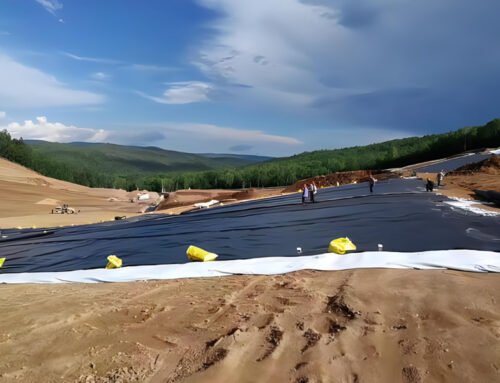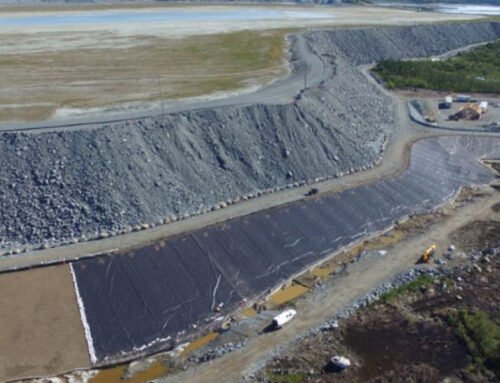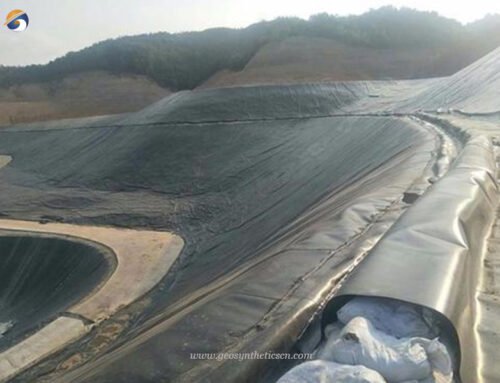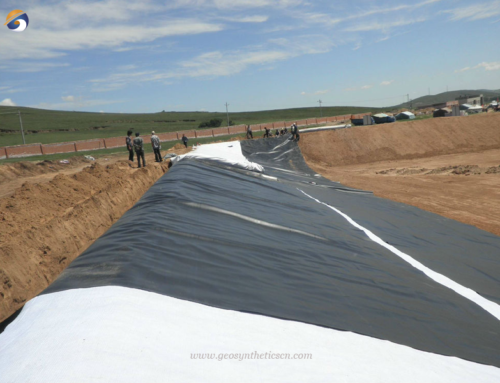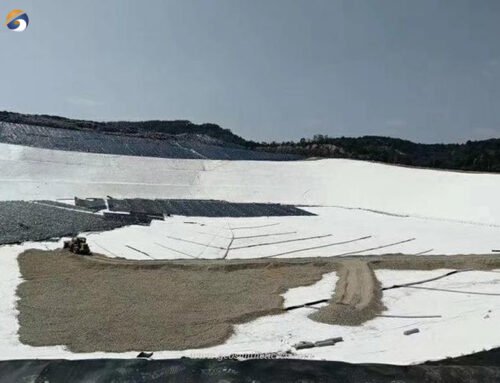HDPE geomembrane sheet, or HDPE geomembrane liner, is a highly impermeable liner manufactured from high-grade polyethylene material. It is widely used in various sectors such as waste containment, water containment, aquaculture, energy, mining, and industrial and civil engineering applications.
1. What Is HDPE Geomembrane Sheet?
The HDPE geomembrane sheet is commonly used in environmental and civil engineering projects. It is widely employed as a liner in landfills, ensuring the containment of waste materials and preventing their leakage into the surrounding soil and groundwater.
Additionally, HDPE geomembrane sheets are utilized in water containment systems such as ponds, reservoirs, and canals. They serve as a reliable barrier, preventing the seepage of water and enabling the efficient retention and management of water resources.
The sheet is manufactured with additives like carbon black, antioxidants, anti-aging agents, and UV-resistant components. These additives enhance its chemical resistance, stress crack resistance, permeability resistance, and ability to withstand UV radiation.
In energy, mining, and industrial projects, HDPE geomembrane sheets are crucial for preventing leaks, chemical corrosion, and environmental degradation. Their impermeability, chemical resistance, and UV resistance make them suitable for protecting infrastructure, containing hazardous materials, and safeguarding the environment.
2. Why Choose HDPE Geomembrane Sheet for Tailings Treatment Project in Peru
The mining industry’s growth in Peru has resulted in a substantial accumulation of ore and, consequently, a significant volume of tailings. However, these tailings frequently contain high concentrations of metals, heavy metals, and residues from mineral processing. In the event of environmental pollution, the consequences can be severe and far-reaching.
When approached by a Peruvian client with a tailings disposal project, we recommended the use of a 2mm HDPE geomembrane and provided installation instructions through instructional videos. In such projects, an impermeable geomembrane is typically employed to prevent seepage from the base of the heap leach tank. As part of the anti-seepage system, the HDPE drainage pipe is indirectly installed on top of the impermeable geomembrane. A layer of protective soil is placed beneath the pipe to ensure the stability of the geotechnical fittings during the accumulation of ore.
By utilizing the 2mm HDPE geomembrane, our solution offers reliable seepage prevention and helps maintain the integrity of the tailings disposal system. We prioritize providing efficient and effective solutions tailored to our clients’ needs, ensuring the successful implementation of their projects while adhering to best practices and industry standards.
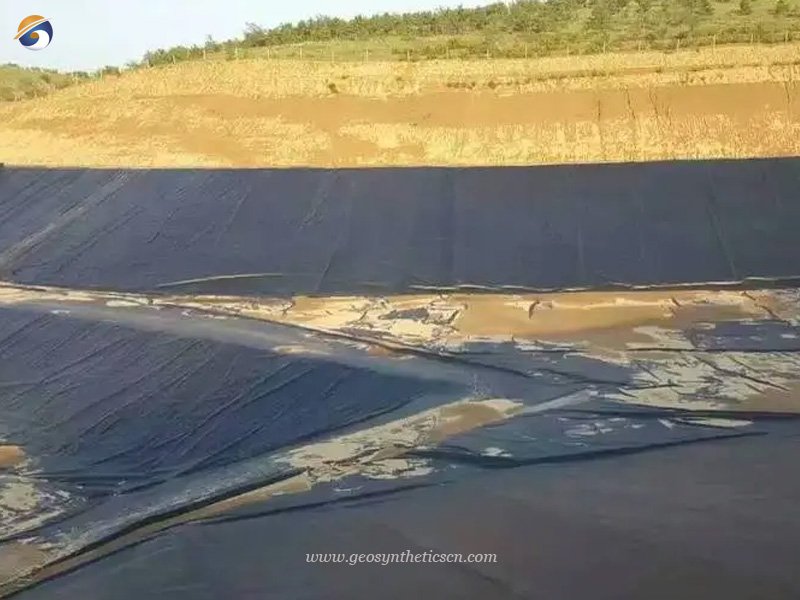
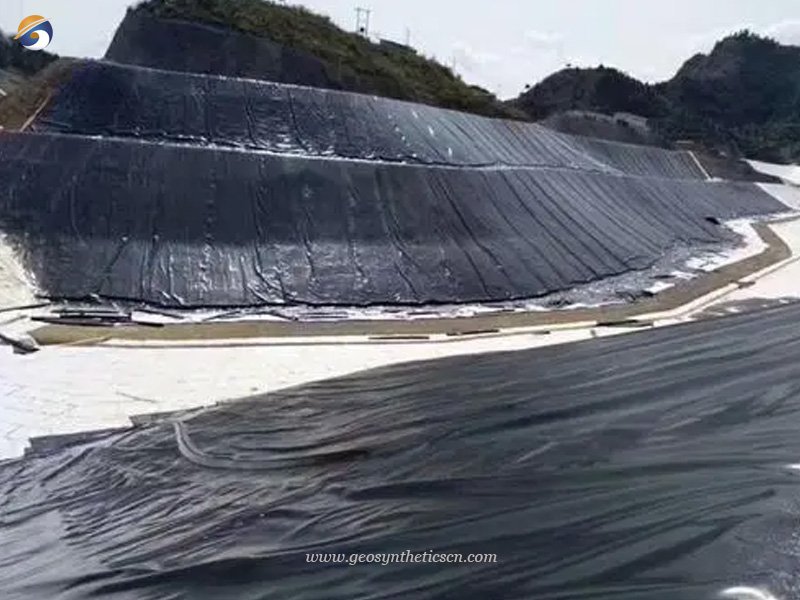
3. How To Install Geomembrane Sheet For Tailings Treatment?
3.1 Preparation before geomembrane sheet laying
(1) Level the ground on the site so that the surface is flat and compacted, and there are no bumps, large stones, iron wires and other hard things on the ground surface to prevent the impermeable membrane from being damaged;
(2) A 40*40 anchoring trench was dug around the landfill to prepare for the anchoring of the anti-seepage membrane on both sides of the tailings.
3.2 Geomembrane Installtion
(1) Flatten the geomembrane roll to be laid in the open space, and cut it into the required shape according to the predetermined plan;
(2) To avoid man-made damage during the film laying process, it should be smooth, compact, and minimize wrinkles. Reasonably choose the laying direction, minimize the force on the seam, and reasonably arrange the position of each piece of material, and strive to make the seam more perfect. less is better;
(3) Lay the geomembrane sheet on the flat ground. Reasonably calculate and select the appropriate method of laying the membrane. The standard is to reduce the number of welded joints and save materials. During the process of laying the membrane, it is necessary to avoid man-made damage. Laying in the shape of a “T” shape. In addition, when laying the membrane, pay attention to reserve the deformation and expansion of the geomembrane. Generally, 1%-4% of the extension is reserved, which is determined according to the actual situation of the specific site, so as to prevent the anti-seepage membrane from being compressed when the foundation is deformed. tear;
(4) All exposed geomembranes must be immediately compressed with sandbags or other heavy objects to prevent the geomembrane from being blown up by the wind or pulled out of the surrounding anchorage ditch.
3.3 Geomembrane welding
The climate conditions required for geomembrane sheet welding and seaming are: atmospheric temperature between 4-40°C; dry conditions, especially no precipitation or other excessive moisture such as fog or dew; wind speed not greater than level 4 per hour.
(1) Hot melt welding
The geomembrane membrane blocks must overlap 15cm before welding, and the membrane blocks must be adjusted so that the seams minimize wrinkles and the possibility of “fish mouth”; before welding and seaming, the seamed area must be cleaned before seaming to clean and free water, dust, debris or any debris.
(2) extrusion welding
Geomembrane seam welding requires 7.5cm overlap. Clean the area pre-weld: no water, dust, or debris. Hot air device for geomembrane heating, avoid damage. No polishing; maintain clean, dry welding rod.
3.4 Geomembrane sheet welding details
Use a soft ladder on the tailings pond slope. Employ a hot-melt welding machine from top to bottom. Lift equipment manually when reaching the platform. For 1:3 to 1:2 slopes, align recessed geomembrane. Ensure smooth welding with no repairs needed. After completing the weld, secure with sandbags in grooves. Anchor membrane at platform with pebbles.
(1) When welding from top to bottom, stop welding when welding reaches the platform.
(2) When the weld seam outside the platform is finished, press the geomembrane into the anchor groove at the platform, and the seam is exposed;
(3) Use a hot air gun to blow the overlapping parts of the two pieces of geomembrane together;
(4) Use grinder sandpaper to roughen (above 1.5mm). Chamfering angle is 45°. Oxide layer on membrane requires roughening. Thickness after chamfering is about 0.5mm. Small unevenness increases contact area. Good welding effect achieved. Extrude welding rod with machine for connection. Treatment completed.
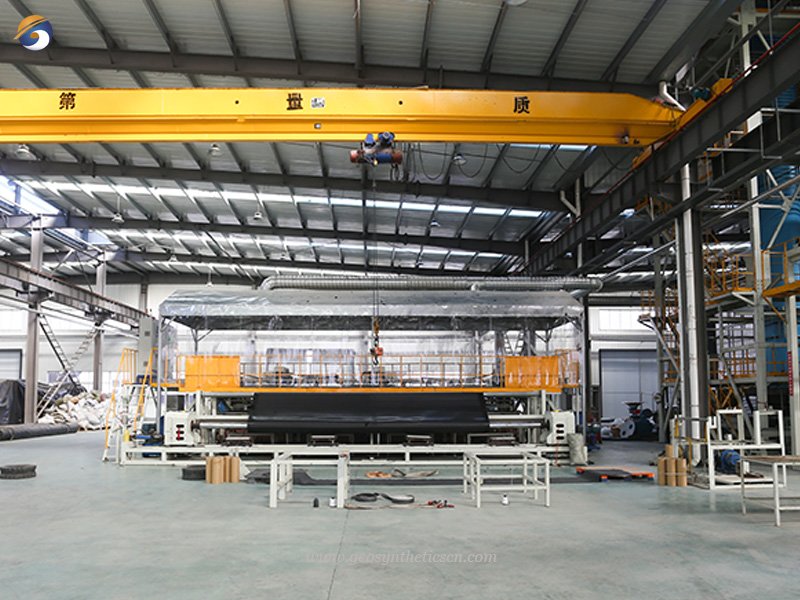
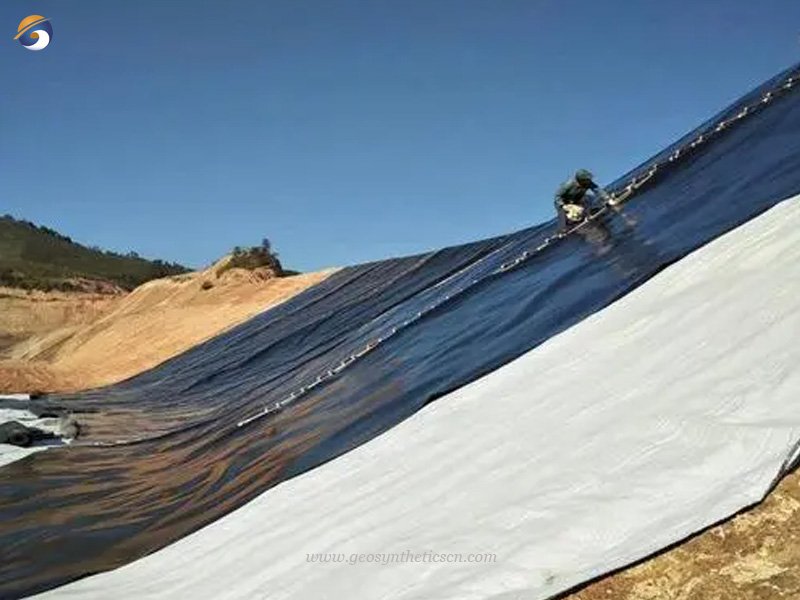
4. What Are Advantages of HDPE Geomembrane Sheet for Tailings Project
HDPE geomembrane sheets offer numerous advantages for tailings projects:
4.1 Isolation, Protection, Stabilization, and Reinforcement
HDPE geomembrane sheets serve multiple functions, including isolating and protecting underlying soil or structures, stabilizing the tailings, and providing reinforcement to the project site.
4.2 Excellent Chemical Stability
HDPE geomembrane sheets exhibit strong resistance to corrosion from strong acids, alkalis, and oil, making them highly effective as an anti-corrosion material in tailings projects.
4.3 Superior Mechanical Properties
These sheets possess good mechanical properties, such as high tensile strength, impermeability, corrosion resistance, and resistance to aging. These properties ensure their durability and reliability in tailings containment.
4.4 High Tensile Strength
HDPE geomembrane sheets have high tensile strength, enabling them to meet the requirements of high-standard engineering projects and withstand the demanding conditions of tailings projects.
4.5 Geotechnical Reinforcement
With a good friction coefficient and tensile strength, HDPE geomembrane sheets offer geotechnical reinforcement, enhancing stability and preventing erosion or shifting of the tailings.
4.6 Adaptability to Harsh Conditions
These sheets can withstand various harsh geological and climatic conditions, including uneven settlement and strong strain. They maintain their performance even in challenging environments.
4.7 Resistance to External Forces
HDPE geomembrane sheets can withstand external forces during construction, resisting damage and maintaining their integrity. They exhibit minimal creep over time.
4.8 Weather Resistance and Anti-Aging Performance
These sheets have strong weather resistance and anti-aging properties, enabling them to be exposed to the elements for extended periods while retaining their original performance.
5. Specicfications of HDPE Geomembrane Sheet for Tailings Treatment Project in Peru
- Total HDPE Geomembrane quantity–29,000 squares meters
- Geomembrane Specifications – 2mm
- Each roll size is 7m*50m
6. Summary
The HDPE geomembrane sheet is highly effective for tailings treatment in Peru. Composed of 97.5% high-density polyethylene and 2.5% additives, it offers numerous benefits. Manufactured from high-quality virgin resin, this composition provides exceptional properties.
Key advantages include resistance to environmental stress cracking and chemical corrosion, ensuring integrity under challenging conditions. Its excellent chemical resistance protects against harmful chemicals in tailings. The material’s wide operating temperature range and long service life suit diverse applications like biogas digesters, tailings storage sites, and more.
Using HDPE geomembranes in tailings treatment ensures reliable containment, preventing contaminant release into the environment. Its durability, chemical resistance, and longevity make it ideal for long-term effectiveness of tailings storage and protecting the ecosystem.
GEOSINCERE has been dedicated to manufacturing geomembrane and geosynthetics products and solutions to worldwide customers since its foundation in 2007. Our main innovative, high quality products include geotextiles, geomembranes, geogrids, geocells, geosynthetic clay liners, and drainage boards, etc al. If you have any questions or inquiries, please contact us, we will reply as soon as possible.

